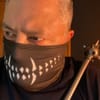Thunderbolts*
Cucumber! Cucumber! Cucumber!

An unconventional team of antiheroes embarks on a dangerous mission, forcing them to confront the darkest corners of their pasts.
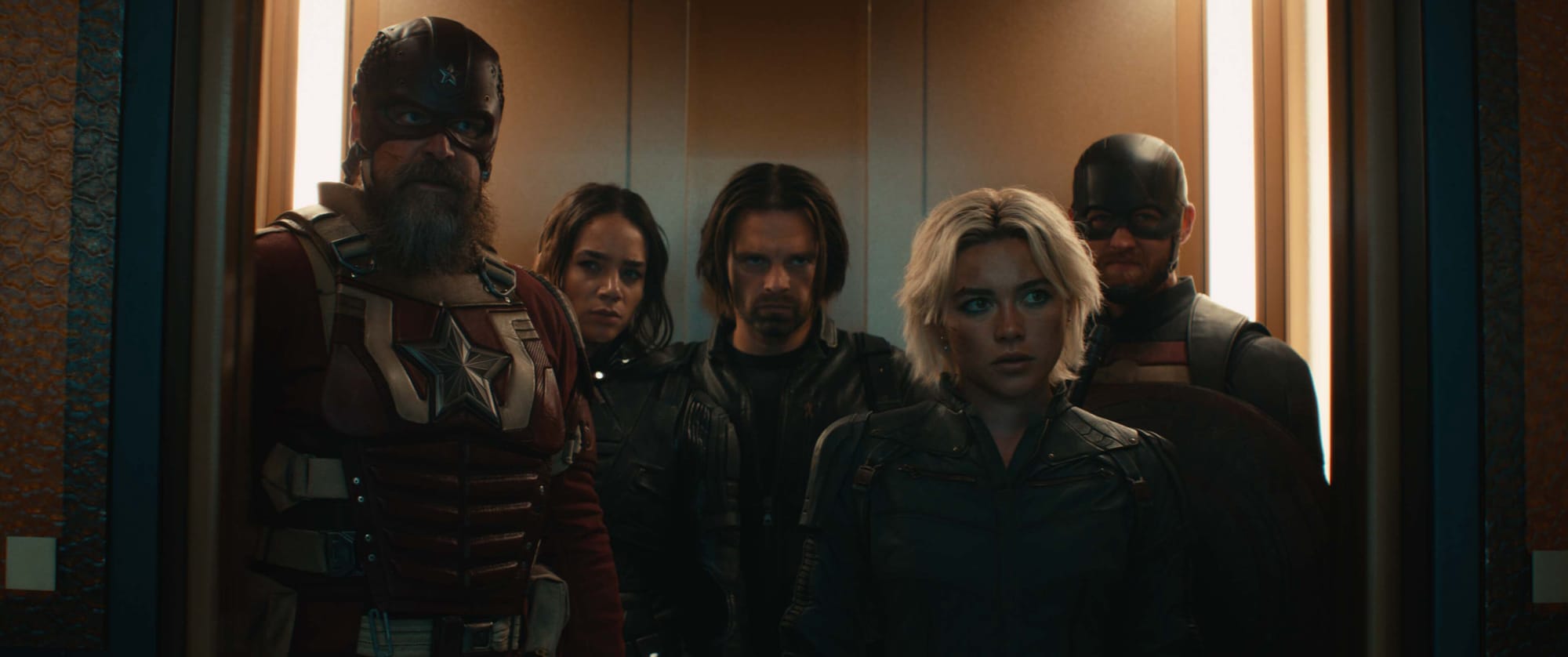
Way back in the late 20th Century, Marvel Comics was struggling.
The tidal wave that was the comic book boom of the 90s was finally beginning to recede, as the market found itself flooded with dozens upon dozens of X-titles and Spider-titles and Bat-titles and little else. On top of that, the Speculator Bubble had burst too, as all those chromium die-cut variant covers turned out to be worth nothing, and suddenly all those dipshits, who spent years scrambling to find every gimmick cover the various comic book companies put out, found themselves with nothing but stacks of worthless trash. To this day, you still can’t give away a full set of all five variant covers of X-men vol 2, issue #1 (1991), but at least all the people who originally bought multiple copies of the same X-Men comic, just with different cover art, aren't as filled with regret as the suckers who are stuck with three copies apiece of all eight variant covers of DV8 #1. Then, like a perfect storm to make matters worse, all of Marvel's wrong-headed decisions to diversify into dead-end markets and dive headfirst into trading cards and other nonsense finally caught up to them, and left in its wake a veritable mountain of accumulated debt.
In the end, Marvel Comics declared bankruptcy.
This is why Sony ended up owning parts of Spider-man, and Universal ended up owning parts of the Hulk, and still do to this day. It's also why Fox ended up with the X-Men and the Fantastic Four, for awhile at least, but not anymore.
This bankruptcy led Marvel Comics through a myriad of hands on the wheel and more than a bit of corporate restructuring, and eventually to becoming enough of a success that Disney purchased them for $4 billion, and the world has never been the same since.
But at the time… shit was real bad.
At one point, desperate to find an audience for its non-Spider or X characters, Marvel was doing dumb shit left and right, like killing off Tony Stark and replacing him with a teenage version of him that was either from the past, or maybe he was from the future, or maybe he was from the past and was brought forward to fight an evil future ancestor of Tony's, or something like that? I don’t remember at this point, and it doesn’t matter because it was very brief, and has since very rightfully been forgotten. Basically, if it wasn’t an X-men title, Marvel couldn’t make it work, and even their successful X-titles were only getting worse with each issue.
During the height of all this dumb crap, Marvel had a line-wide cross-over event, which is a story that involves every character and title that Marvel publishes, and in that story, Professor X of the X-Men broke bad for some dumb reason that I no longer remember or care about, and for some reason that I also don't remember or care about, this resulted in him becoming a big monster guy called Onslaught, who then decided to take over the world, or maybe he just liked hitting people, I don't remember, and who cares, anyway, the long and the short of it was that he was fighting everyone, and it was a big to-do, and blah, blah, blah.
So... during the climax of the story, Marvel made it seem like Onslaught killed Captain America, Iron Man, the Fantastic Four, and the various members of the Avengers, but in actuality, they had been shuffled off into a pocket universe. This allowed Marvel to bring in some big name creators, to start all of these characters over from scratch, and use this rebooting as a jumping-on point to introduce new readers to this stable of characters who had fallen out of fashion. They called this effort Heroes Reborn.
And despite some now rather dubious legacies...
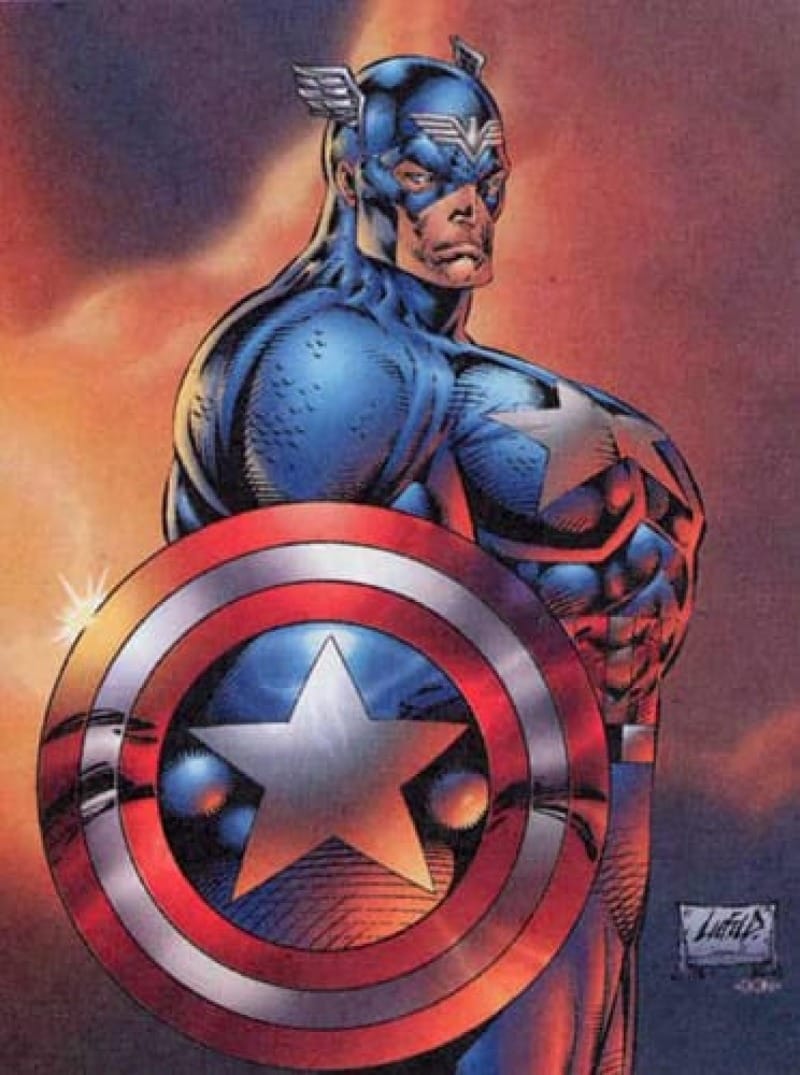
It was a big success, lasting for about a year or so, and this led Marvel back to focusing on creators, and initiatives like the Ultimate Universe. Meanwhile, while Captain America, Iron Man, the Avengers, and the Fantastic Four were all busy in the Heroes Reborn Universe, the characters still in the main universe (known as the 616 Universe) thought that they were all dead. So, in their absence, a new team of heroes showed up. They were called the Thunderbolts, and they promised justice… like lightning!
The only problem was, it was all a con.
Citizen V, Techno, MACH-1, Songbird, Atlas, and Meteorite, they were actually a team of opportunistic supervillains in disguise known as the Masters of Evil. This was revealed in a legendary end-of-the-first-issue twist that Marvel managed to keep secret—something they could never pull off these days—and the fans ate it up. For the next year, the story of the Thunderbolts, and the struggle of the villains to stay evil, or to maybe turn good for real, was the hot title on the shelf.
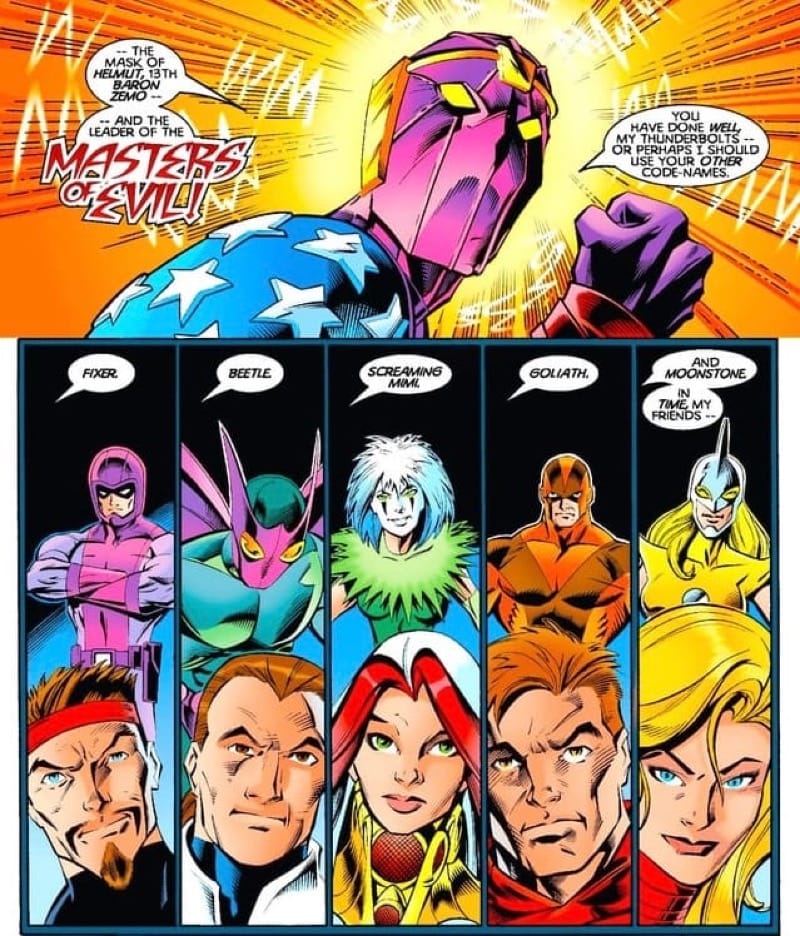
It was a lot of fun.
Of course, you can only run the will-they-or-won't-they story for so long. As Moonlighting taught us all, eventually they have to kiss. And after that, there wasn’t much left to say. The story was done.
But the title, The Thunderbolts, that still had value.
So after that, there were relaunches, rebrands, and re-imaginings. The team rooster waxed and waned and changed its members. They were fugitives for a while. Then they were "unregistered hero" hunters for the government during the Superpower Registration Act era. Then they were bad guys again, this time while posing as the Avengers, but due to some corrupt officials, they were the officially sanctioned team. After that, the team became more of a suicide squad type thing, operating out of the supervillain prison known as The Raft. And now, these days, I think they’re more of a dirty dozen type thing, and the team is made up of a lot of loners and anti-heroes. In short, The Thunderbolts have always been a team of outsiders and outlaws and fallen heroes looking for redemption.
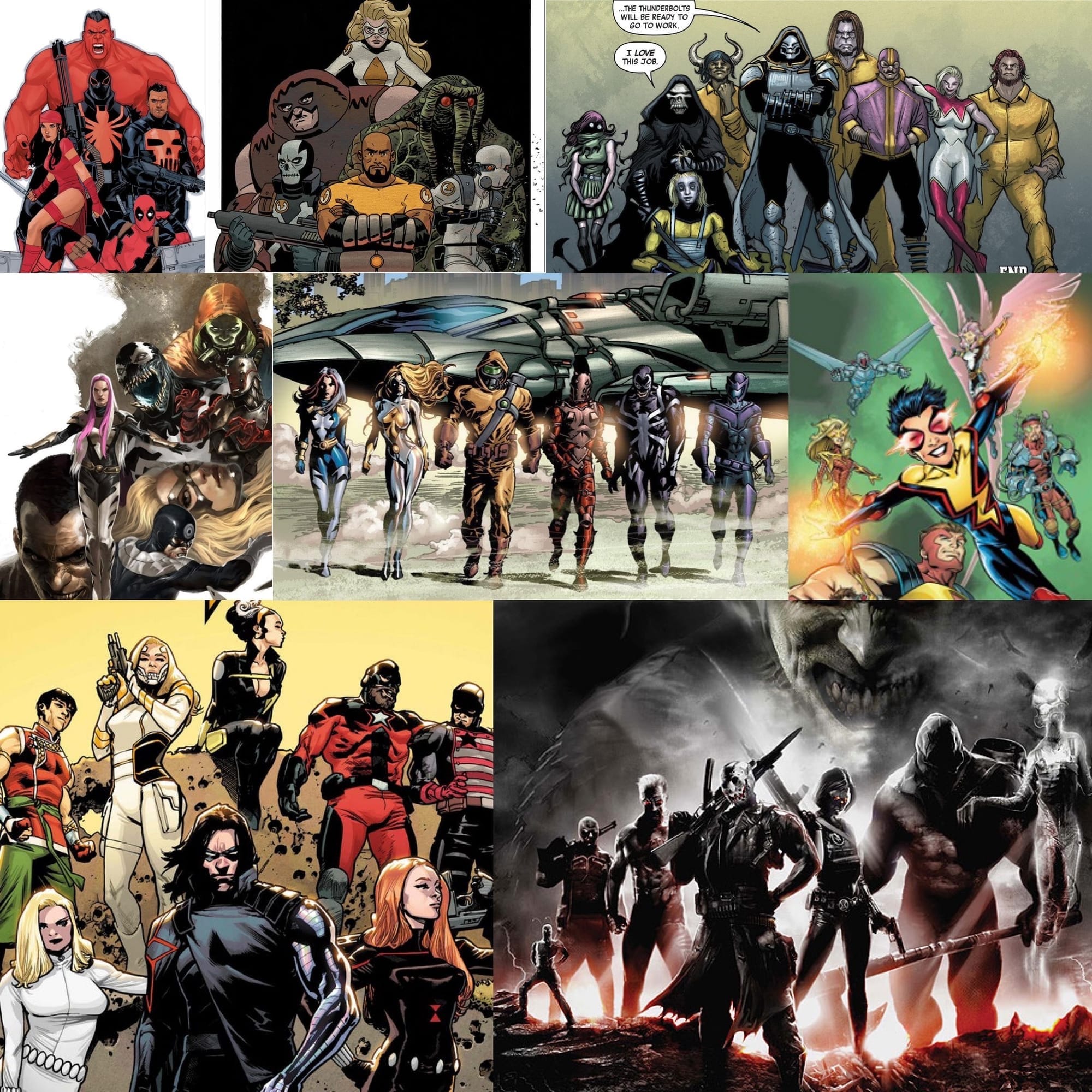
And that last one is the version that the team is using in this film... a bunch of outsiders, outlaws, and fallen heroes looking for redemption. This is all much to the bitter consternation of the usual band of whiny comic book nerds who not only refuse to let go of the original idea, but to also admit that the MCU is a different continuity from the 616 Universe that appears in the comic books, so the original idea just isn't possible.
But anyway...
The Characters
Yelena Belova - The new Black Widow? The White Widow?
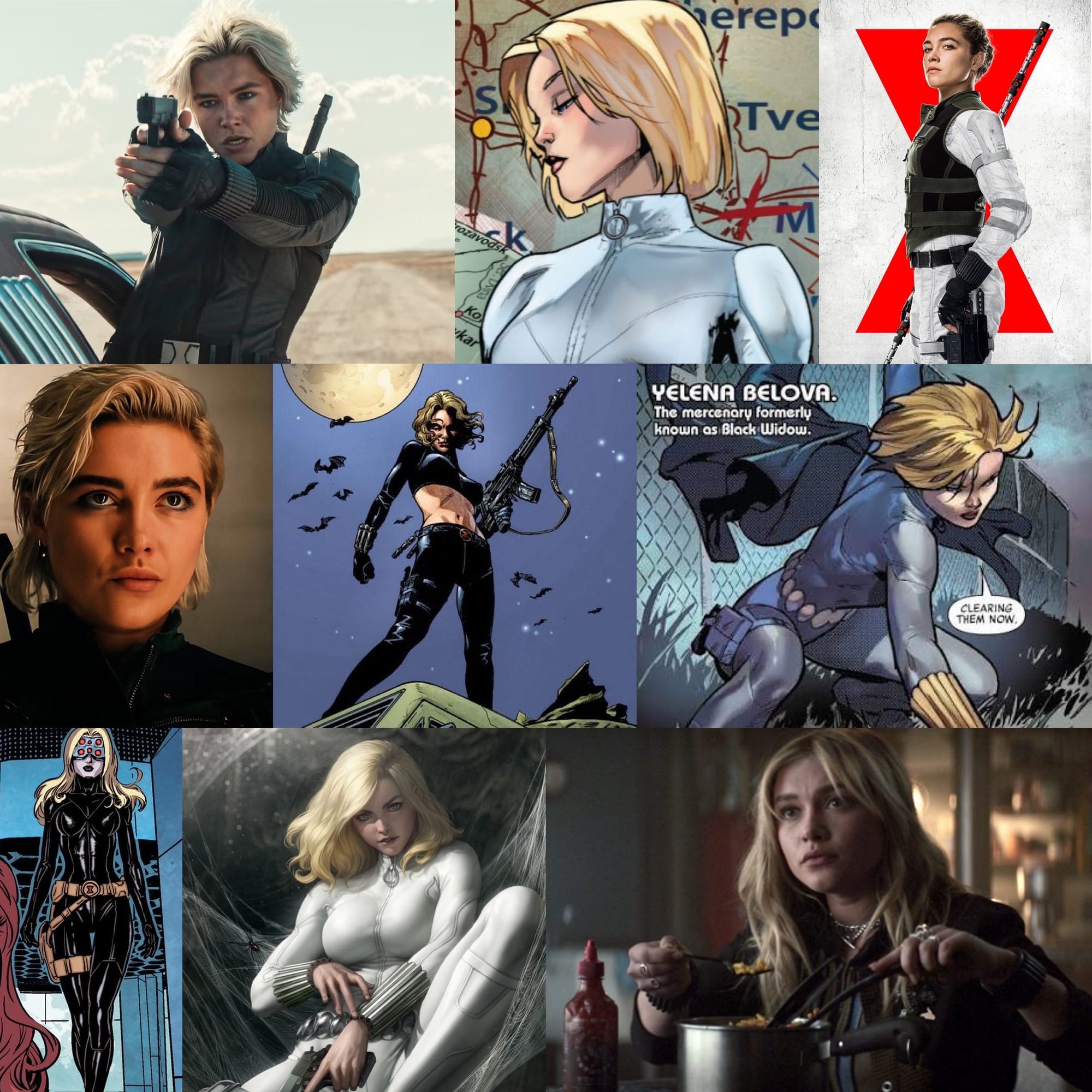
Created by writer Devin Grayson and artist J. G. Jones, Yelena Belova first appeared as a sketch in Marvel Knights: Wave 2 Sketchbook #1 in January of 1998, before debuting a year later in Inhumans vol 2 #5 in January 1999 by writer Paul Jenkins and artist Jae Lee.
Like Natasha Romanov, Yelena was trained as an assassin in the Soviet super-soldier program known as the Red Room, and became the second modern-era character to use the Black Widow moniker. Originally sent to kill Natasha, the two became allies and have since worked together often. At one point, Yelena was kidnapped by Hydra and A.I.M. and used as a guinea pig a joint project to create a new version of the Super-Adaptoid, which is a cyborg-type creature that can mimic superpowers, and she was then sent to crash the wedding of Luke Cage and Jessica Jones, because that's just the kind of shit that happens at superhero weddings. Eventually Yelena was freed, and started going by the name White Widow. Since then, she's been a part of various groups like S.H.I.E.L.D. and the Thunderbolts. She's not really an A-lister in the comics, so she's often used as more of an also-ran type of character in these books.
In the MCU, Yelena is much more of a main star, thanks to Florence Pugh's chrisma and talent. The character has basically got the same history as her comic book counterpart, except that she and Natasha consider each other to be sisters, even though it was only due to them being placed in a deep-cover KGB infiltration unit that was disguised as a family and then inserted into American society, much like on the TV show The Americans, which is one of the best shows ever.
Also, Yelena and Kate Bishop together are some of my favorite moments.
James Buchanan Barnes - Bucky
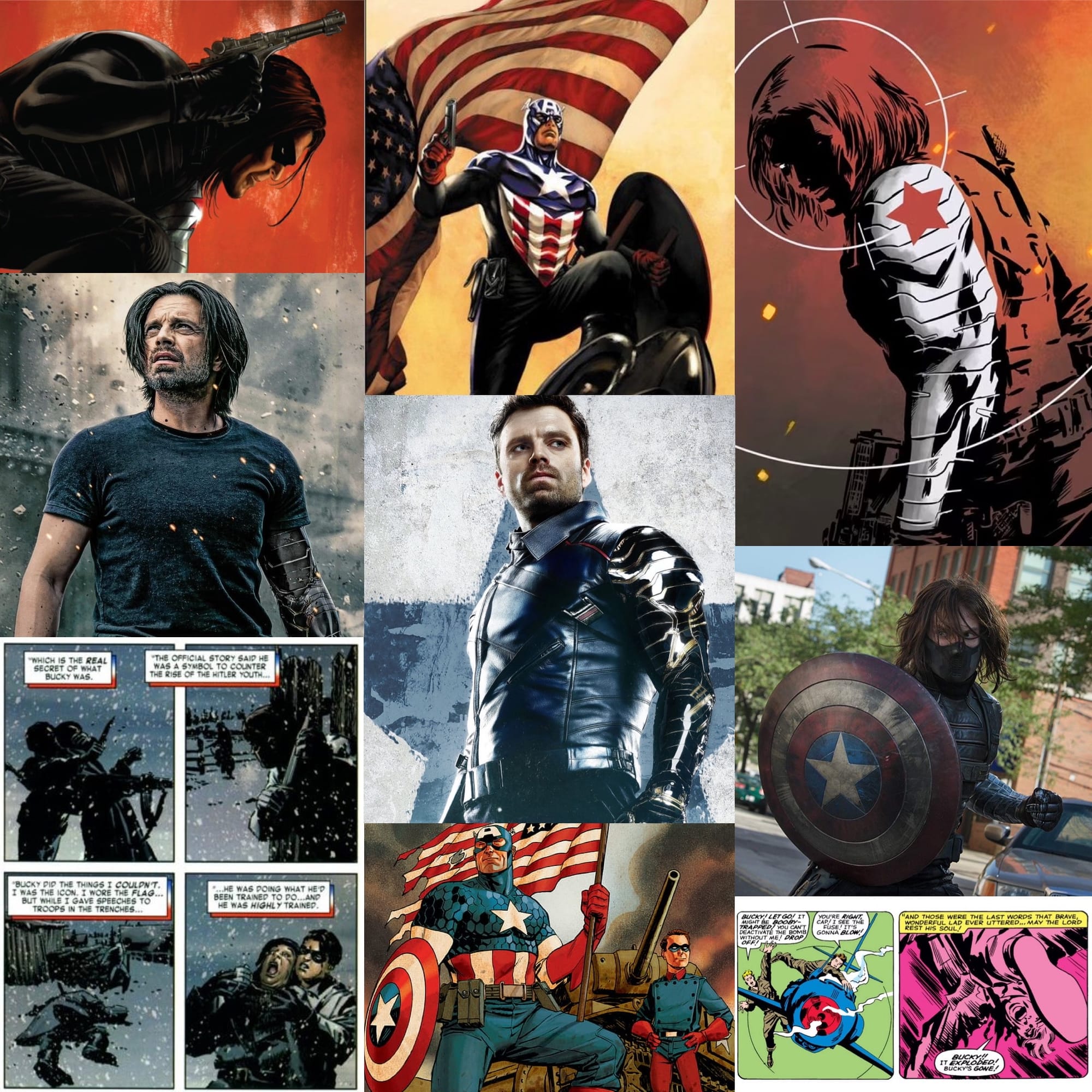
Originally introduced as Captain America’s kid sidekick in World War 2, Bucky was created by Joe Simon and Jack Kirby, and first appeared in Captain America Comics #1 in March 1941, when it was Timely Comics, which was the predecessor to Marvel Comics. He very famously died at the end of World War 2 while trying to defuse a Nazi drone bomb that had been launched at London by the Baron Zemo from WW2. And while multiple characters have since adopted the Bucky persona over the years, there’s only ever truly been one. But despite death having no real power in comics, for years, there was an oft-cited rule in Marvel comics that was brought up whenever some weepy fan was super upset over a character’s death: “Only Bucky and Uncle Ben stay dead.” And for a long time, that was gospel.
But then in 2014, Steve Epting and Ed Brubaker resurrected Bucky as a brainwashed assassin cyborg for the Soviet Union called the Winter Soldier. He had been fished out of the frigid Atlantic by the Russians, and was given a cyborg arm to replace the one that had been blown off, and then spent the last 70 years in cyrogenic suspended animation, when he wasn't taking out Cold War targets all throughout the latter half of the Twentieth Century. They aged Bucky up a bit too, making him more of an age with Captain America, instead of a 12 year old boy that Steve Rogers dressed in bright colors and then took into combat.
Eventually, Bucky’s memories and personality were restored after your typical superhero bruhaha, and since then he has struggled a bit to find his place in this modern world. At one point, he briefly assumed the mantle of Captain America when Steve Rogers was believed to be dead but was actually in time and hurtling through the timestream, which is something that can happen to superheroes on occasion. Currently, Bucky is at large in the Marvel Universe, fighting the good fight and being a big sad boy/dark hero forever in search of redemption.
In the films, he's basically has the same, except now he’s a Congressman.
Valentina Allegra de Fontaine
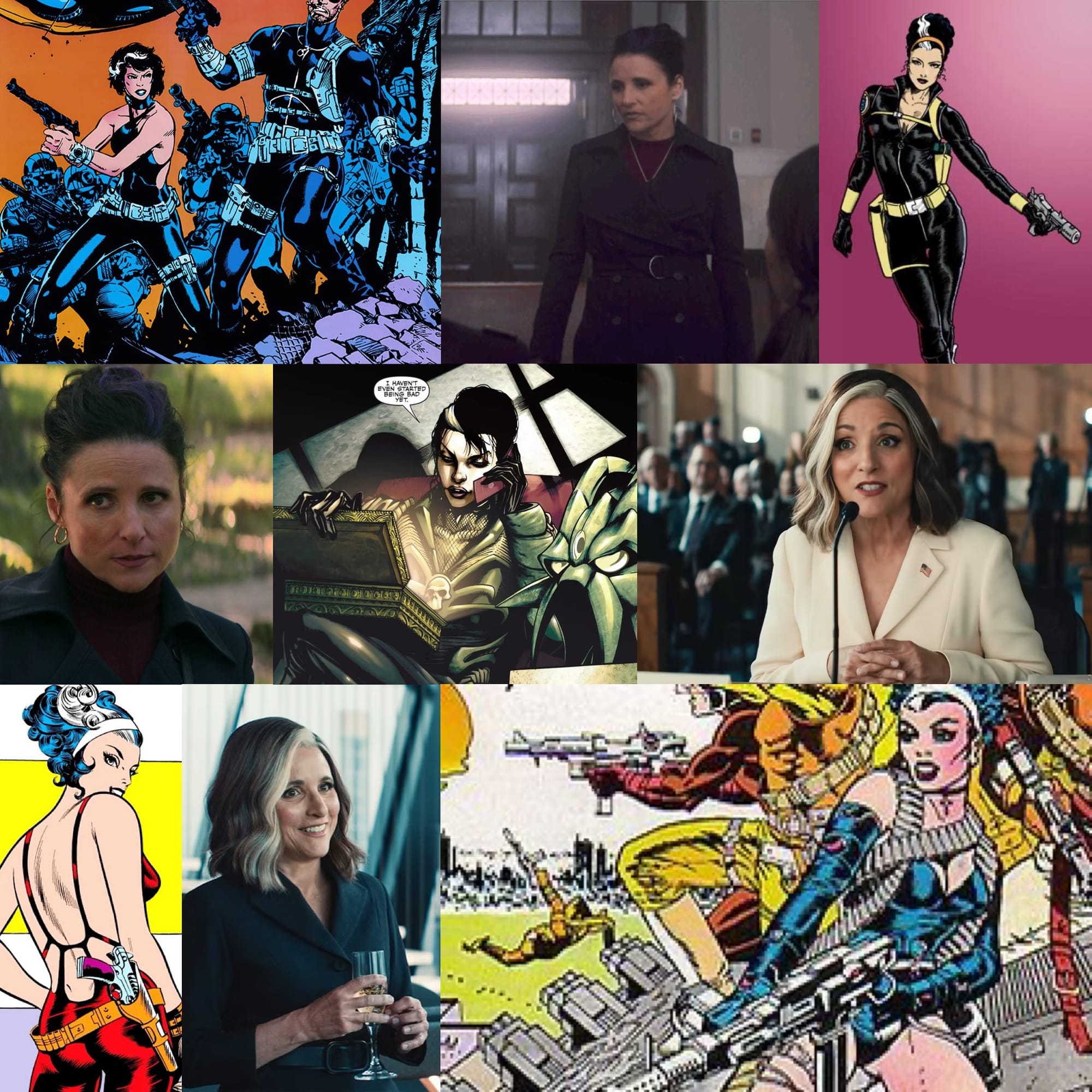
Created by writer-artist Jim Steranko, and first appearing in August of 1967 in a Nick Fury, Agent of S.H.I.E.L.D story in issue #159 of Strange Tales, the Contessa Valentina Allegra de Fontaine has long been portrayed as Nick Fury’s super sexy secret agent love interest. After both her parents were killed for belonging to an unspecified Italian resistance movement when she was a child, de Fontaine lazed about Europen as a jet-setting dilletant for a few years, but ultimately found her life meaningless. Motivated to carry on her parent's legacy, she eventually joined the international espionage agency S.H.I.E.L.D.
In the movie, for all we know, she’s basically the same. She may have been an agent of S.H.I.E.L.D. and she may have dated Fury, she might even be Italian, we don't know. All we do know is that she's a veteran player of game of Washington politics, is someone who is plugged into power, is well-funded, manipulative, and willing to do anything it takes to accomplish her agenda.
Also, she has hair like Tulsi Gabbard, who is both an eager member of the GOP Christian death cult that is currently ruining the world, and also a member of the Hawaiian-based religious cult known as the Science of Identity Foundation. That Valentina has the same hair as this unhinged lunatic bigot is good, because when you're playing a supervillain, it's smart to have a real-life villain that the audience can readily recognize as a touchstone.
John Walker - The U.S.Agent
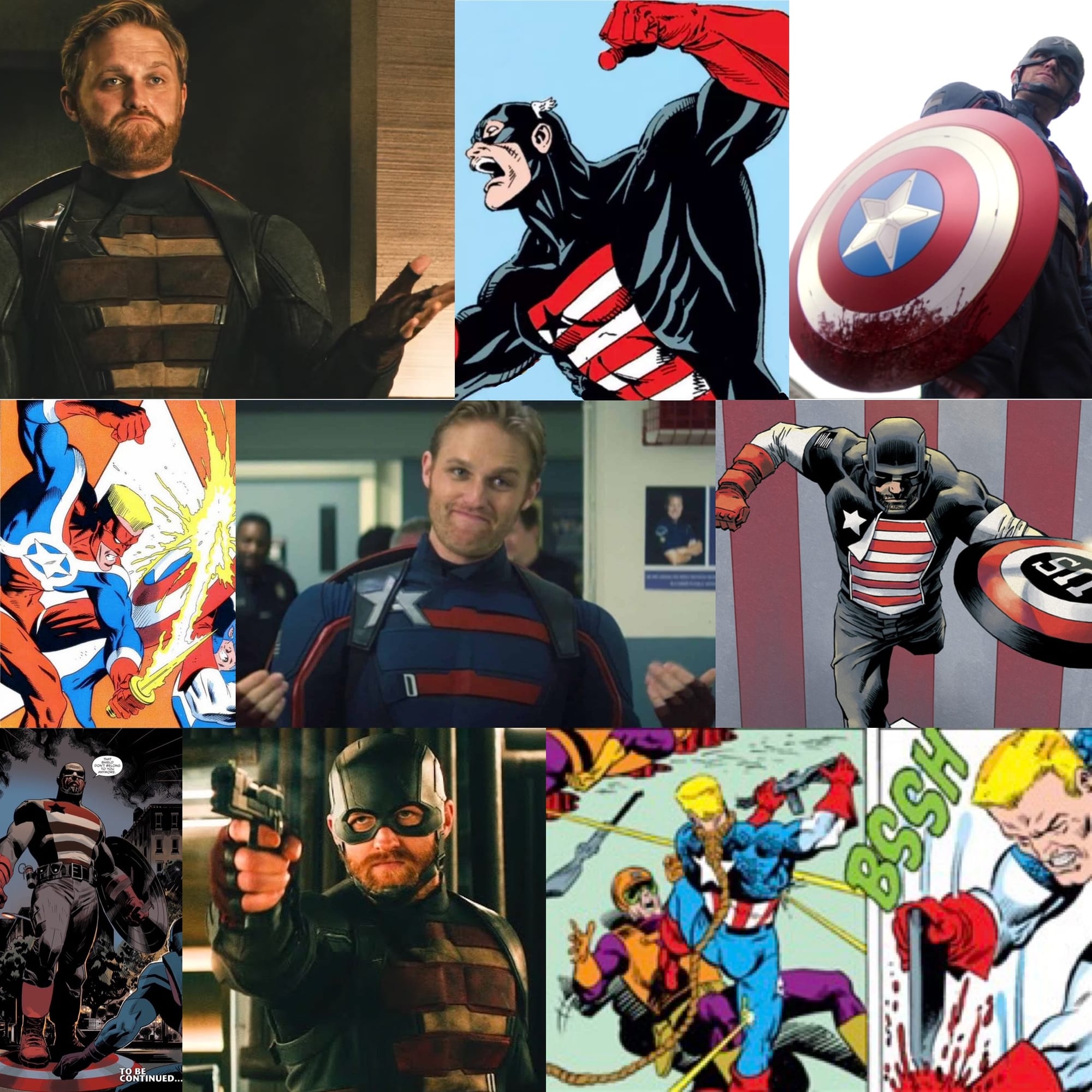
Created by Mark Gruenwald and Paul Neary, John Walker first appeared in Captain America #323 in November of 1986. A former soldier, John Walker dreamed of heing a hero all his life, so he went out and got superpowers, because this is the kind of career option that is available to people in comicbook worlds. Walker goes to the blackmarket geneticist, the Power Broker, a character which is meant as a kind of comic book parody of health and wellness grifters like RFK jr, Dr. Oz, Bryan Johnson, or really any numbnut that drinks raw milk, eats caveman food, or uses essential oils, except the Power Broker's procedures work, and you receives superpowers, instead of dying of stupidity and some entirely preventable reason. So, Walker gets a basic super-muscles package and bursts onto the scene as the dubious superhero, The Superpatriot. It doesn't go well for him. Later, he was chosen as the replacement Captain America, after Steve Rogers refused to be a tool of the U.S. governement, but he failed out hard due to excessive violence and also because Rogers took the shield back, after cracking open a can of whoop ass all over Walker. He then later showed up wearing Captain America's black and red variant costume and calling himself The U.S.Agent. Ever since, he's been Marvel comics' go-to butthole supercop willing to crack heads for the man.
In the movie, John Walker's story is pretty much the same, except he was never known as the Superpatriot, and also, it was Sam Wilson who took the shield back from Walker. Also, in the MCU, John Walker is much less of a butthole, and more of a try-hard jackass, which is pretty entertaining.
Ava Starr - Ghost
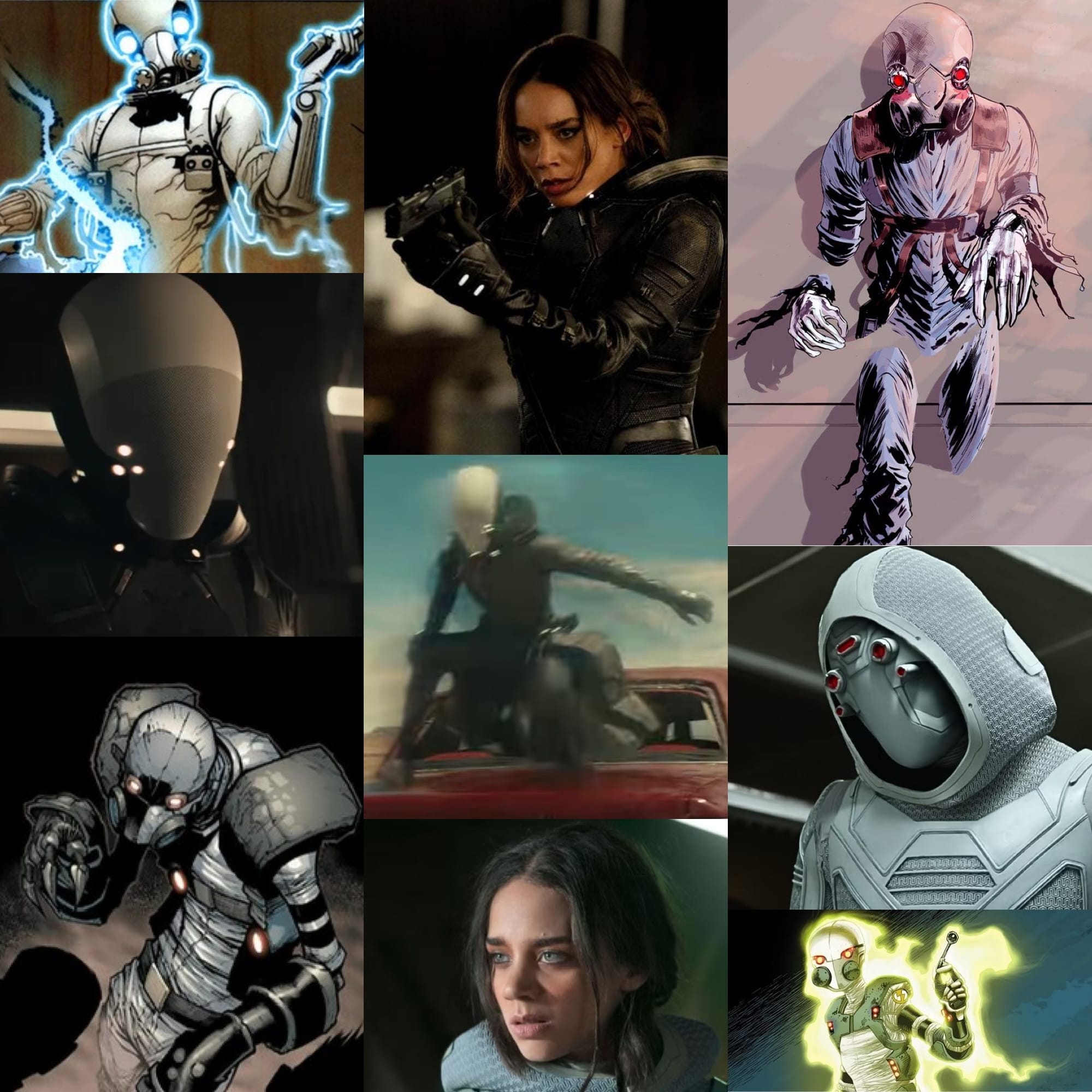
Created by David Michelinie and Bob Layton, the character known as Ghost first appeared in Iron Man #219 in June of 1987. A genius inventor and a hacker, they wear a battle suit that allows them to become both invisible and intangible. Also, they are so paranoid, they never take it off, so they probably smell terrible. Because of this paranoia, very little is known about the identity of the Ghost. They claim to have been an IT researcher at one time, and that they grew disgusted by corporate greed. This is why theybecame an anti-capitalist saboteur and spy, who specializes in destroying political and economic institutions they view as oppressive, and/or unethical, with a particular focus on the ones that deal with advanced technology and surveillance. So, Ghost is kind of an antihero, which is how they ended up on the Thunderbolts.
In the movies, Ghost is not the same at all.
First off, Ava is definitely a young woman. We see her face all the time, especially now that she's got the MCU's favorite folding-back CGI helmet. And while she does have the ability to turn invisible and phase through solid objects too, it's due to an over-exposure to Quantum energy that happened during a failed experiment, as per comic book tradition, but she has difficulty controlling it. Also, this condition is slowly killing her. Because of all this, she has to wear her suit in order to keep her from fading out of existence. It's unclear if Ava is able to take off her suit long enough to shower or not, but I'm gonna guess no, because the whole point is that she can't control her powers, so I bet that she probably reeks of cabbagey gym socks too.
Anyway, a minor antagonist from Ant-Man 2, she has a larger roll here, which is great, because she's pretty fun and her power is cool, but she’s still pretty much the George Harrison of this particular Beatles.
Robert “Bob” Reynolds - The Sentry/The Void
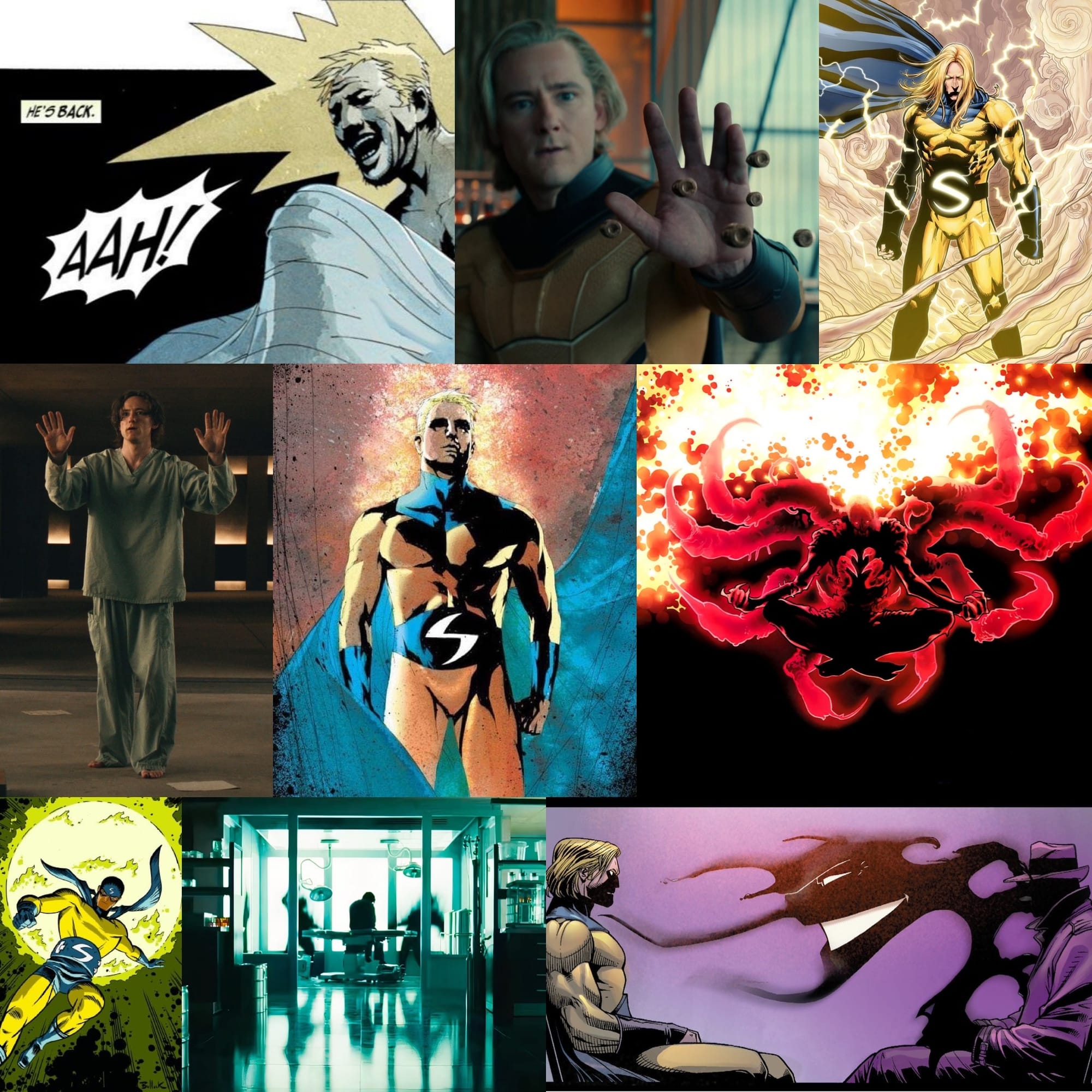
Created by Paul Jenkins and Jae Lee and Rick Veitch, Bob Reynolds first appeared in The Sentry #1 in 2000. He was originally gimmick-marketed as a long lost Stan Lee created character, because the story of The Sentry is that he had been a hero in the Marvel Universe since the 1940s, one who famously fought a villain known as The Void, and for some reason, no one remembers this at all, including himself.
It turns out that Bob is both The Sentry and The Void at the same time, but he isn't aware of this most of the time. And that at one point, Bob finally lost control of his powers, the Void was unleashed, threatening the whole world, and because he was so powerful, the heroes of the Marvel universe had to join together in order to stop him. And because Bob was so dangerous, that once he was stopped, the only option the other heroes had was to combine magic and science and erase all memories of The Sentry and The Void from everyone’s mind, including Bob's. Those mindwipes held for years, but in the year 2000, they finally broke, and the Sentry returned to the Marvel universe. And soon after... so did the Void. It’s been a problem for the Marvel Universe off and on ever since.
In the movies, Bob is a methhead who was bumming around the South Pacific, who had signed up to be a part of a medical experiment because he needed the money. Most of the people who signed up died. Bob didn't, and as a result, The Sentry was born. So was the Void. Now Bob is a problem for the MCU too.
Alexei Shostakov - The Red Guardian
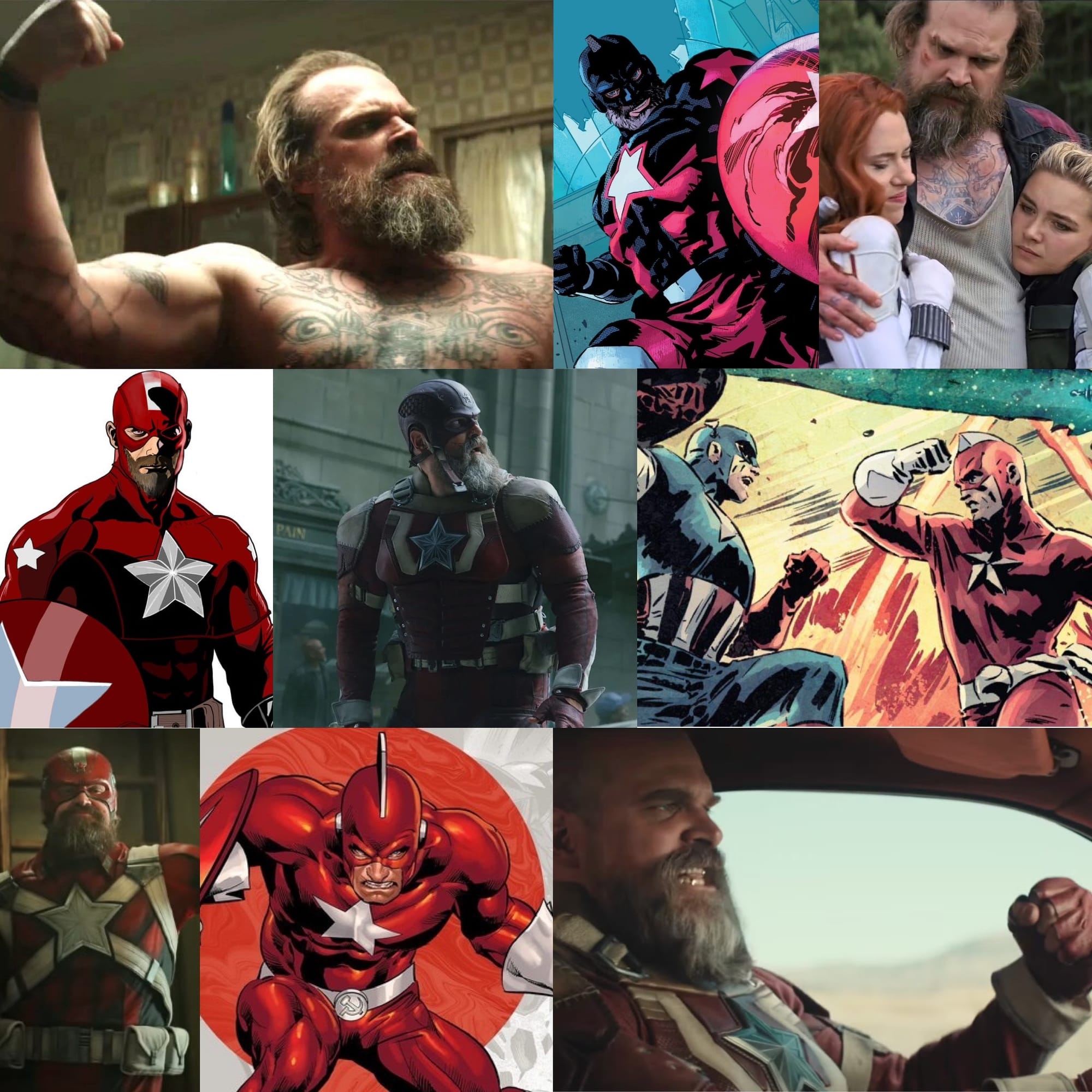
Created at the height of the Cold War by Roy Thomas and John Buscema, the Red Guardian first appeared in Avengers #43 in January of 1967, and was meant to be the Soviet Union's answer to Captain America, and as a result, the idea of the superhuman arms race was born.
Several people have worn the mantle of the Red Guardian over the years, but the first person to be called the Red Guardian in Marvel comics was Alexei Shostakov. Born in Moscow, he and Natasha Romanova were married when they were Soviet agents. Natasha eventually defected for the United States, but Alexei remained loyal to the USSR, and was super bitter and angry about her leaving him. He has often used a shield similar to Captain America's, and has also used a large belt buckle throwing disc too, if you're wondering why at one point in the film Alexei takes off his belt and starts beating bad guys with it.
In the film, Alexei is basically the same, but he is less bitter and angry, and much more of an effusively friendly and bumbling super-strong Russian bear who loved being a hero to the people. Now, all he wants is to be a hero again, and also to be a good dad too, as for a time, he was Natasha and Yelena's adoptive father while they were posing as an American family on a deep-cover KGB assignment. Maybe more than anything, Alexei regrets that he wasn't there enough for "his girls" when they were younger, so he's constantly trying to make up for that.
Antonia Dreykov - Taskmaster
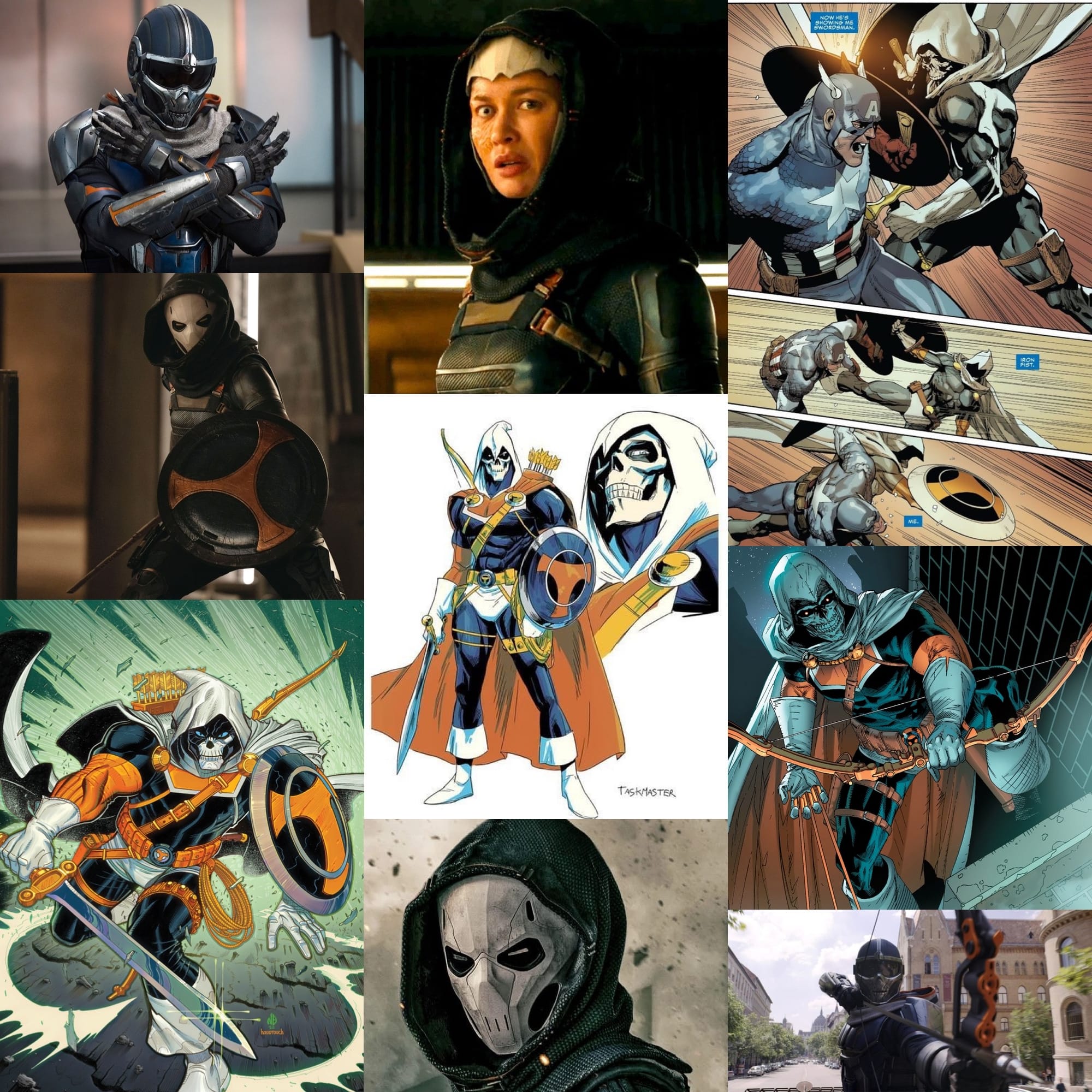
Created by writer David Michelinie and artist George Pérez, Anthony “Tony” Masters debuted in The Avengers #195 in May of 1980. He possesses an ability called “photographic reflexes" that allows him to mimic any fighting style he sees, but at the cost of his long and short-term memory. I'm honestly not sure how that last part works, as I've read stories with this character basically all my life and I don't remember it ever coming up, but to be fair, this could be due to my own long and short-term memory being messed up because I also possess photographic reflexes, but instead of being able to mimic fighting styles, mine manifests as natural video game playing ability.
A mercenary often hired by supervillains and criminal organizations as a training instructor for their henchman and goons, which he then does while dressed as an absolute lunatic, even by comic book world standards, the Taskmaster and his ridiculously flamboyant outfit has fought pretty much every street fighter in the Marvel Universe. He's an all-time classic. The guy gets around.
In the film, however, Antonia Dreykov is a young woman, and a survivor of the same Red Room program as Natasha and Yelena. While she possesses the same abilities as the comic book version of the Taskmaster, unfortunately, she does not possess anywhere near the same sense of style.
Mel - possibly Melissa Gold? - possibly Songbird?
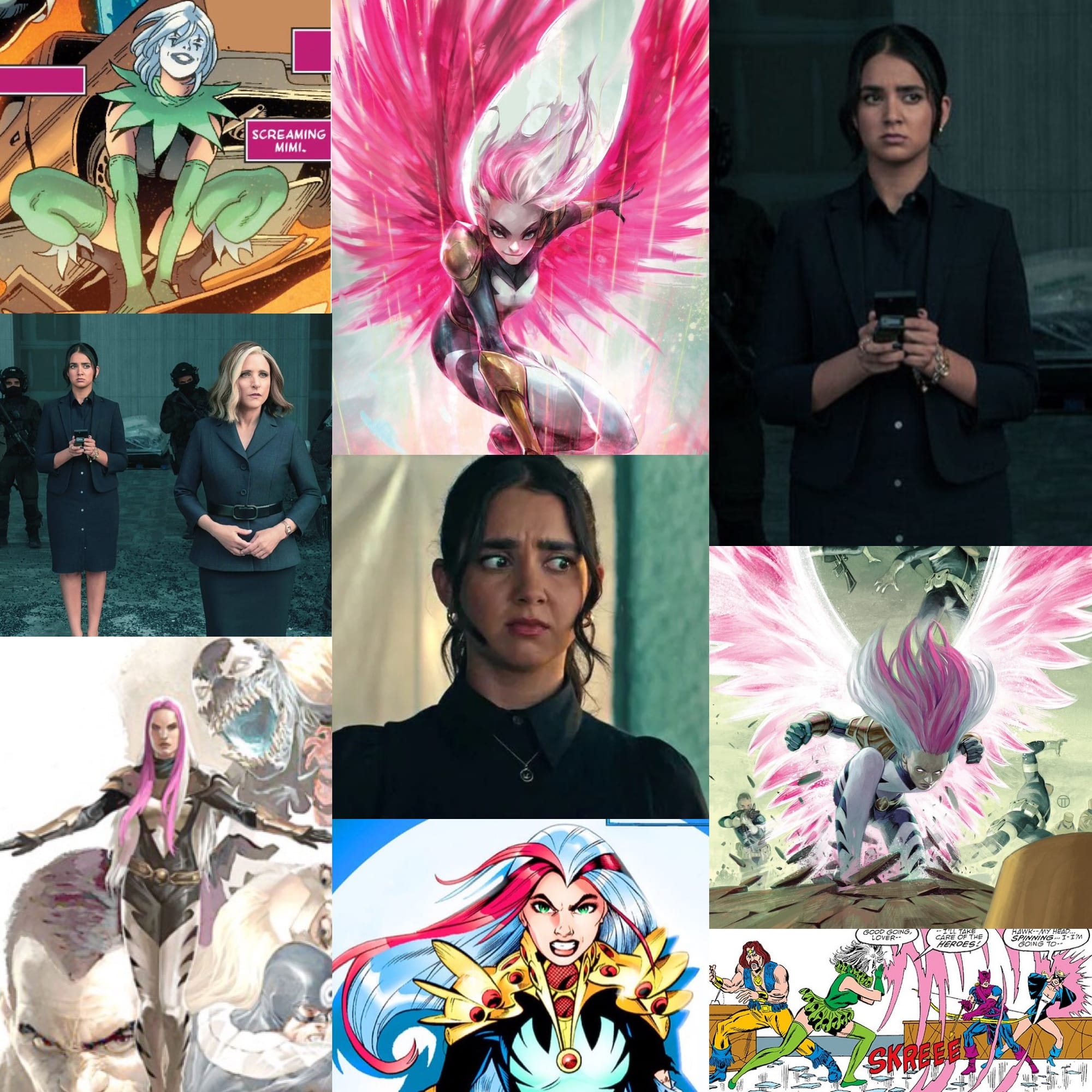
Created by Mark Gruenwald, Ralph Macchio, and John Byrne, Melissa Gold first appeared as the supervillain with a sonic scream, Screaming Mimi, in issue #54 of Marvel Two-in-One in August, 1979, along with her hippy husband, and fellow sonic scream powered supervillain, Angar the Screamer, who wore a denim vest with fringe as his costume. After being a dispoable bad guy for a few decades, Melissa Gold reappeared as Songbird, first in issue #449 of the Incedible Hulk by Peter David and Mike Deodato Jr. in January 1997, and then in Thunderbolts #1 in April 1997 by Kurt Busiek and Mark Bagley. As Songbird, she now uses her sonic powers to create "hard light" objects, like wings that she then uses to fly, because of the hi-tech collar she wears. Since then, she's been a regular member of various incarnations of both the Thunderbolts and also the Avengers.
In the movie, Mel is Valentina’s put-upon and hesitant assistant, and most importantly, she may not be Melissa Gold at all. We don't know her full name, or even her last name. She's just Mel. The only reason people think she might actually be Melissa Gold is the fact that she wears a necklace that looks a lot like it might be a songbird sigil... so, who knows. Maybe.
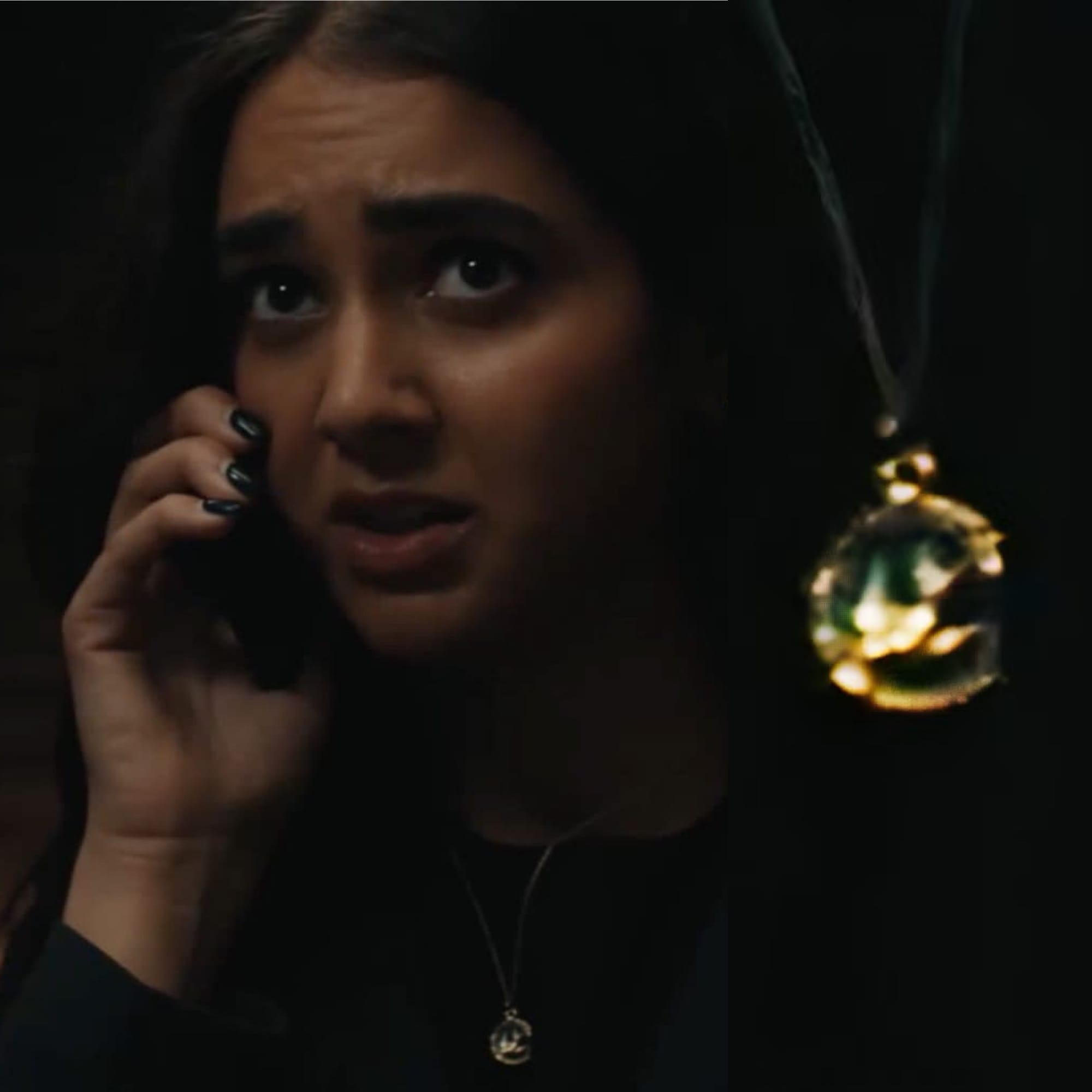
And that’s basically everybody…
The Movie

Yelena Belova is feeling empty and directionless. She had just found her sister, Natasha, again. She had just been freed of the mental shackles of the Red Room. And then she gets wiped out of existence for five years during The Blip. When she returns, she finds out that her sister is now dead, after having sacrificed herself to save reality. In the time since, she has been bouncing around the world in the employ of CIA director Valentina Allegra de Fontaine as a black ops assassin. Now finally, after destroying a lab in Malaysia for Valentina, who is desperately trying to erase all evidence of her involvement with something called the "Sentry" project, Yelena has had enough. She's gonna quit working in the shadows. She wants to be clean. She wants to be more like who Natasha was.
But after finding her "father" Alexei living in low rent squalor while trying to get a third rate limo service off the ground and ready to do anything Valentina asked if it meant that he would be able to get back in the game, a dishearted Yelena calls in, and requests her next assignment.
Facing imminent impeachment for her various illeagal black ops dealings, and desperately looking to tie up all of her loose ends in a mad scramble to save her own ass, Valentina separately dispatches Yelena, John Walker, Ava, and Antonia Dreykov to the same hidden covert facility, tasking each one of them with killing the other as a spy. In the ensuing fight, the group accidentally release an amnesiac, possibly bi-polar, former methhead named Bob from a cryo-pod stacked amongst the papers and boxes containing Valentina's myriad loose ends, all right before the doors all slam shut and they realise two things...
- The room they're standing in is actually a big incinerator.
- They're all loose ends too.
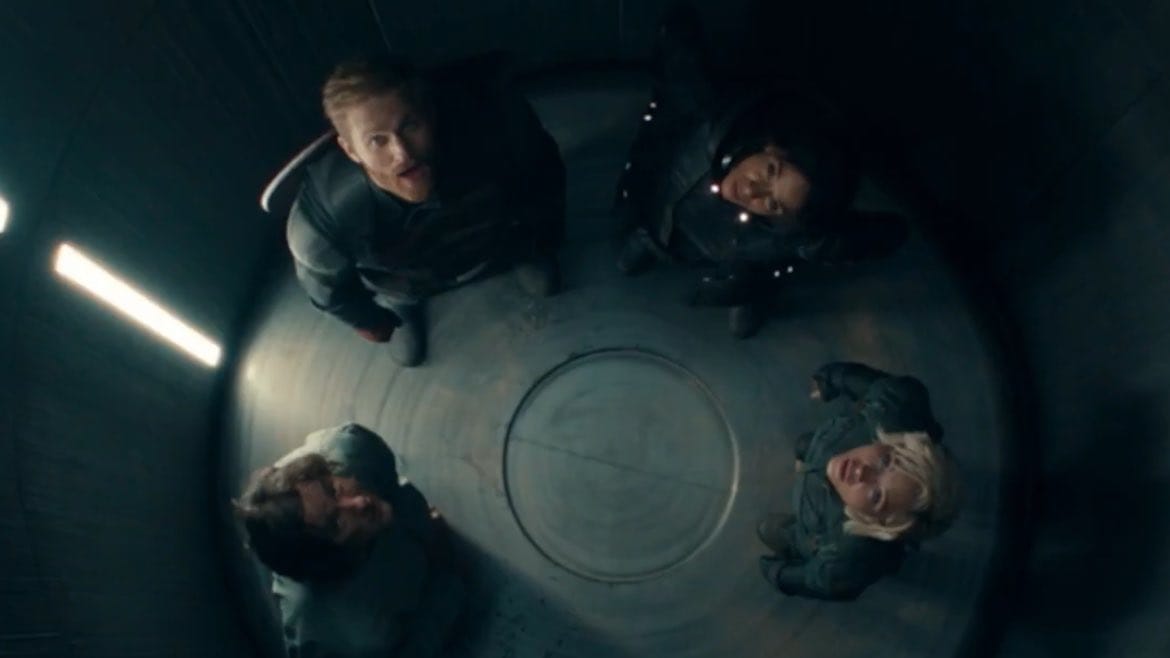
There's only one way out, and that's together. As they work to escape this trap, Yelena and Walker both make physical contact with Bob, and briefly experience visions of some of their worst memories.
Meanwhile, Valentina learns that the group has survived, and also that Bob was the only survivor of the Sentry trials, so she sends a response team to take out the group and capture Bob. When she arrives at the site, Bob creates a fatal diversion by drawing enemy fire, so that Yelena, Walker, and Ava are able to escape, which to the surprise of everyone turns out to be not fatal at all, and Bob unleashes some very impressive powers before passing out.
Valentina transports Bob to the former Avengers Tower in Manhattan, now she has renamed as the "Watchtower, which answers a question that has been hanging around since Spider-Man: Homecoming as to who bought Avengers tower. Now, in an effort to stave off impeachment, and score political points, Valentina intends to quickly introduce Bob to the world as a new super-powered protector called The Sentry, all the while wielding the implied threat of him in D.C. as her own personal weapon against anyone who might try to remove her from power.
Meanwhile, Alexei Shostakov has overheard the details of Valentina's plot because Mel had rented his limo that evening for Valentina to use to get to a Washington D.C. power-party.
Determined to save Yelena, he power chugs some Mountain Dew and hot-foots it across the country, and shows up in the desert in his limo to rescue the group. And despite her protests otherwise, he is over the moon to see that Yelena is now a part of a super team, and is making some new friends, and he is even happier when he hears Walker joke that the team is called the Thunderbolts, as it's a reference to a pee-wee soccer team Yelena played on in her childhood, one that he coached. And even though one of the players took a poo at mid-field one time, his memories of Yelena being on the West Chesapeake Valley Thunderbolts, sponsored by Shane’s Tire Shop, or maybe it was Dimitri’s Elite Industrial Lighting and Electronics, depending on who you ask, are good ones.
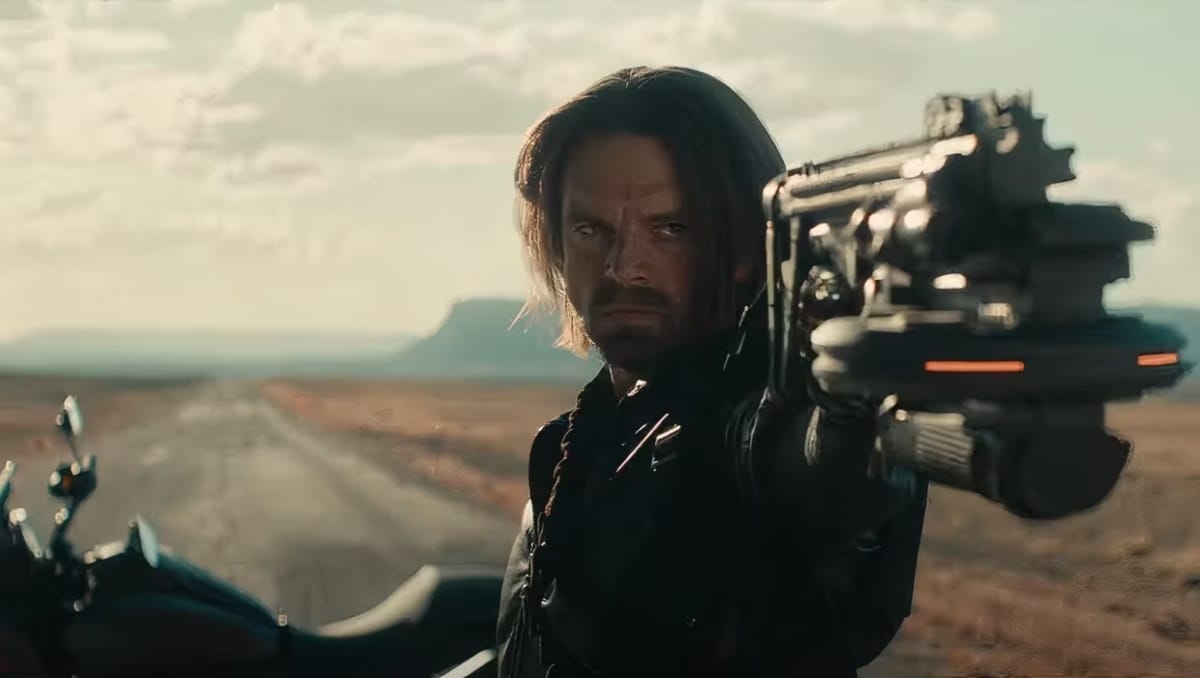
Unfortunately, Valentina has not forgotten about them.
Pursued by her goons across the desert, the Thunderbolts are saved by, and then apprehended by, the arrival of Congressman James Buchanan "Bucky" Barnes (D - NY10). Bucky is an unimpressive and ineffectual freshman congressman, who very clearly coasted on his reputation of having punched both Nazis AND Aliens really good. An obvious Glamour Congressman, the legislative version of someone taking a potbelly pig for a walk in a busy public park specifically so that people will come up and talk to them, Bucky intends to turn that perception around by bringing in the Thunderbolts and having them testify in Valentina's impeachment hearing.
However, upon learning from Valentina's assistant Mel that Bob is a dangerously powerful superhuman, as well as mentally unstable, Bucky joins the Thunderbolts and they all head to New York to try to stop Valentina at the Watchtower before she can introduce The Sentry to the world. Unfortunately, once they arrive, they discover that Valentina has already manipulated Bob into joining her side.
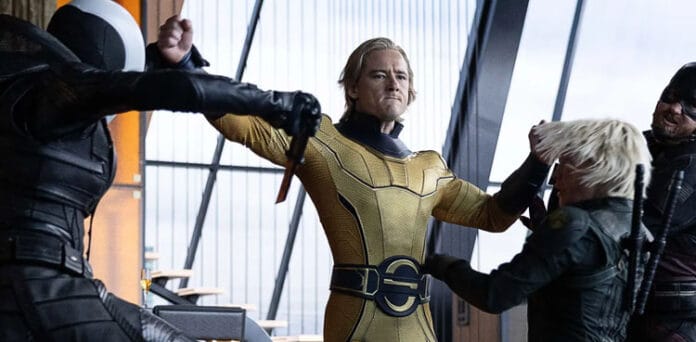
He beats the tar out of them pretty easily.
The Thunderbolts have to run. This is, to say the least, pretty demoralizing for a team of people who don't have the best self-esteem levels to begin with.
Meanwhile, Bob has started getting twitchy, and turns on Valentina, and is only saved when Mel incapacitates Bob with a failsafe kill switch they put in his head. Unfortunately, this just makes shit worse, as Bob isn't dead, and the kill switch merely triggered the emergence of the Void, Bob's destructive alter ego, and the horrifically powerful shadow-demon-like embodiment of all his depression and insecurities due the experimental procedure he was subjected to, making his already fractured psyche much worse.
The Void begins engulfing New York City in a creeping darkness that swallows people whole, leaving behind only their shadows.
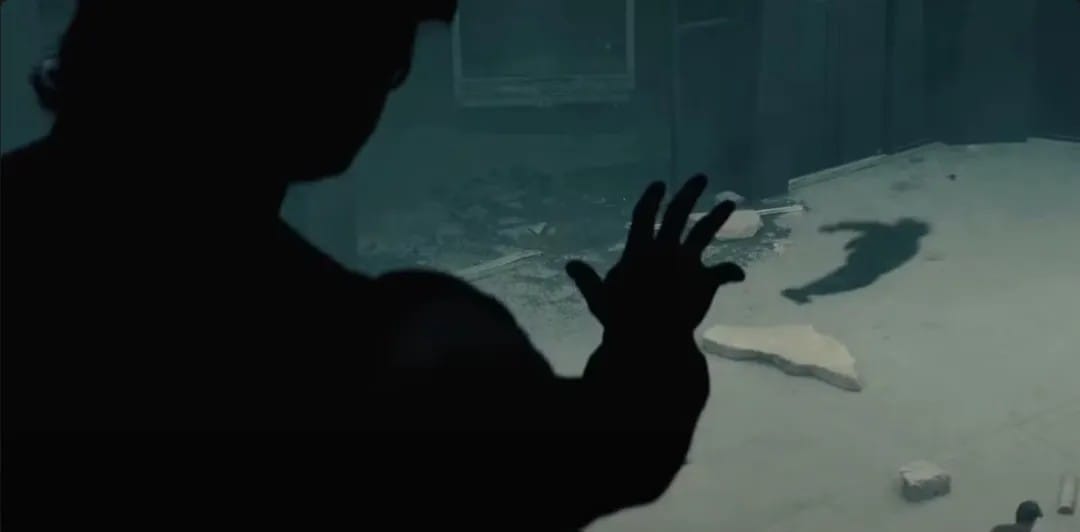
After trying to save as many people as they can, the Thunderbolts realize that the only way to stop the Void is from within, so Yelena enters the darkness to rescue Bob. There, she faces a series of memories from her own terrible past, but she is eventually able to find Bob hiding in a memory of his childhood bedroom, where he would hide from his father's abuse. Soon enough, the other Thunderbolts join them, and together they battle through an M.C. Escher-esque reality of terrible memories, until finally, once they figure out that punching doesn’t solve anything here, but understanding does, theyare able to free Bob from the Void, through the power of togetherness and emotional support.
Their solidarity empowers Bob to regain control, the shadows recede, the victims are freed, and light returns to the city.
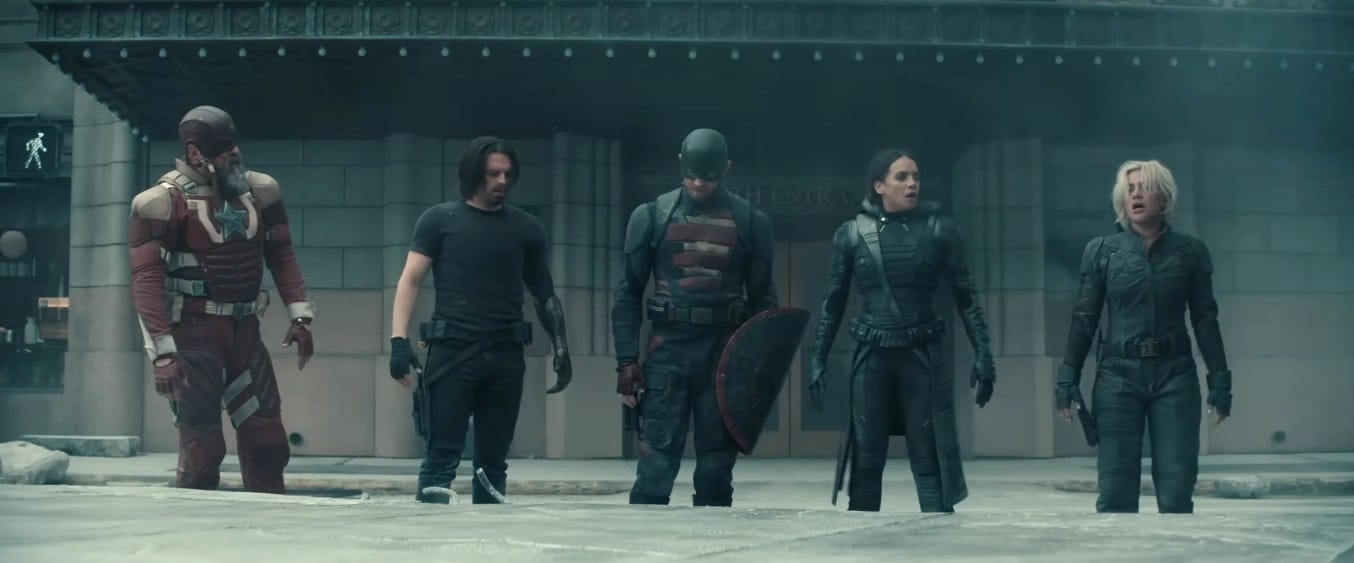
With the threat neutralized, the Thunderbolts go to apprehend Valentina, but she tricks them into joing her in a waiting press conference in which she introduces the Thunderboltsd to the public as the New Avengers, while taking all of the credit for herself. The Thunderbolts go along with her, but Yelena quietly warns Valentina that they will be watching her from now on.
Then, in a post-credits scene in the Watchtower, as the New Avengers and Bob discuss an on-going fued with Sam Wilson over the use of the Avengers name, and how Sam intends to sue them for trademark infringement, they receive a distress signal, and are greeted on-screen with an image of an extra-dimensional spacecraft entering the atmosphere.
It has a large "4" emblem on its side...
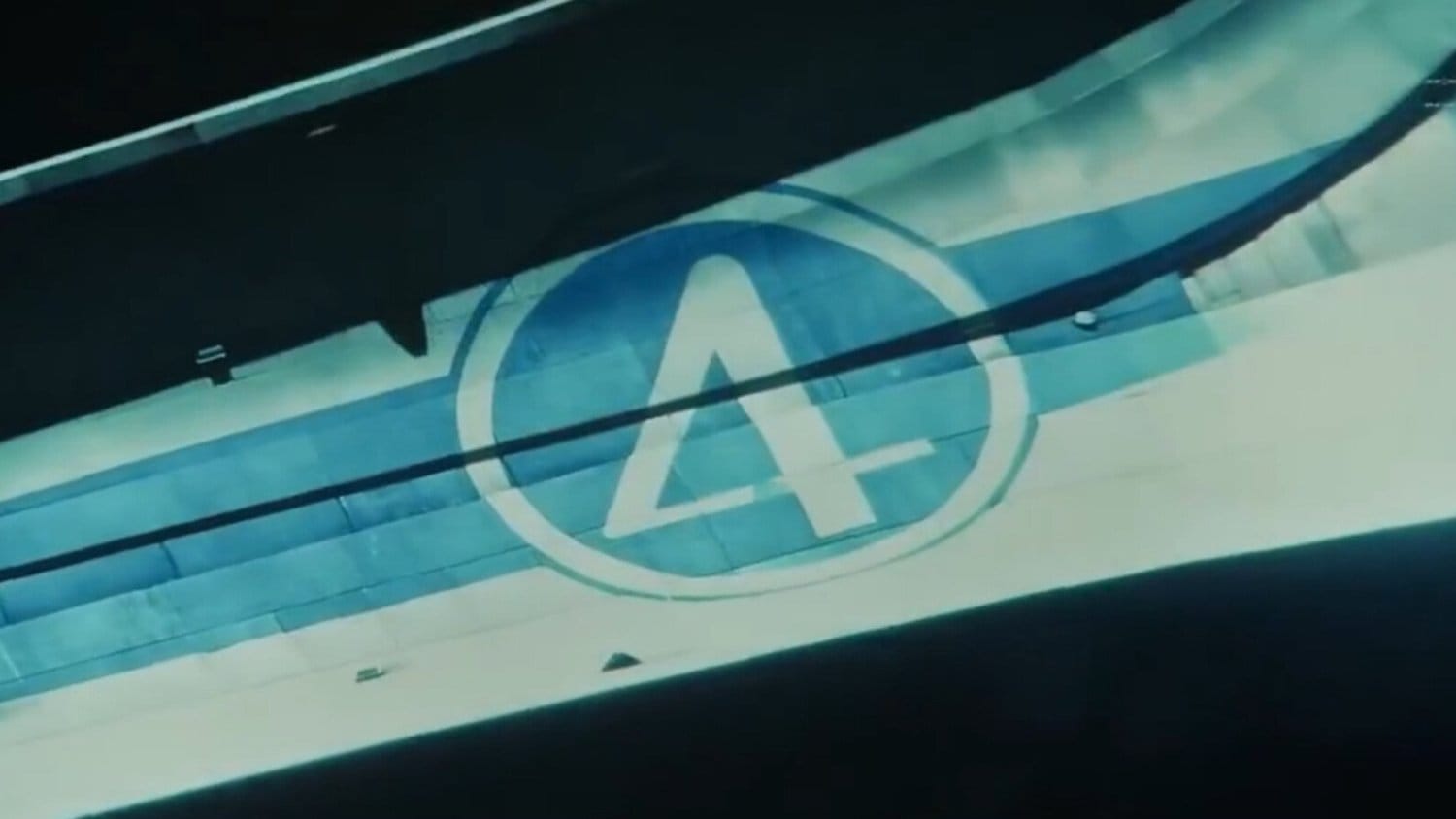
Gosh, I wonder what that means...
Coming at a time where the success of the MCU has created enough people whose entire lives seem to revolve around nothing more than waiting for the franchise to fail, The Thunderbolts is a stylish and fun superhero film, and all while also being an examination of living with trauma and mental health issues, asking: "What if simple human connection was powerful enough to save the world?" Because that's the idea this film hinges on… ever since the events of Infinity War and Endgame, the Avengers are gone. They disbanded.
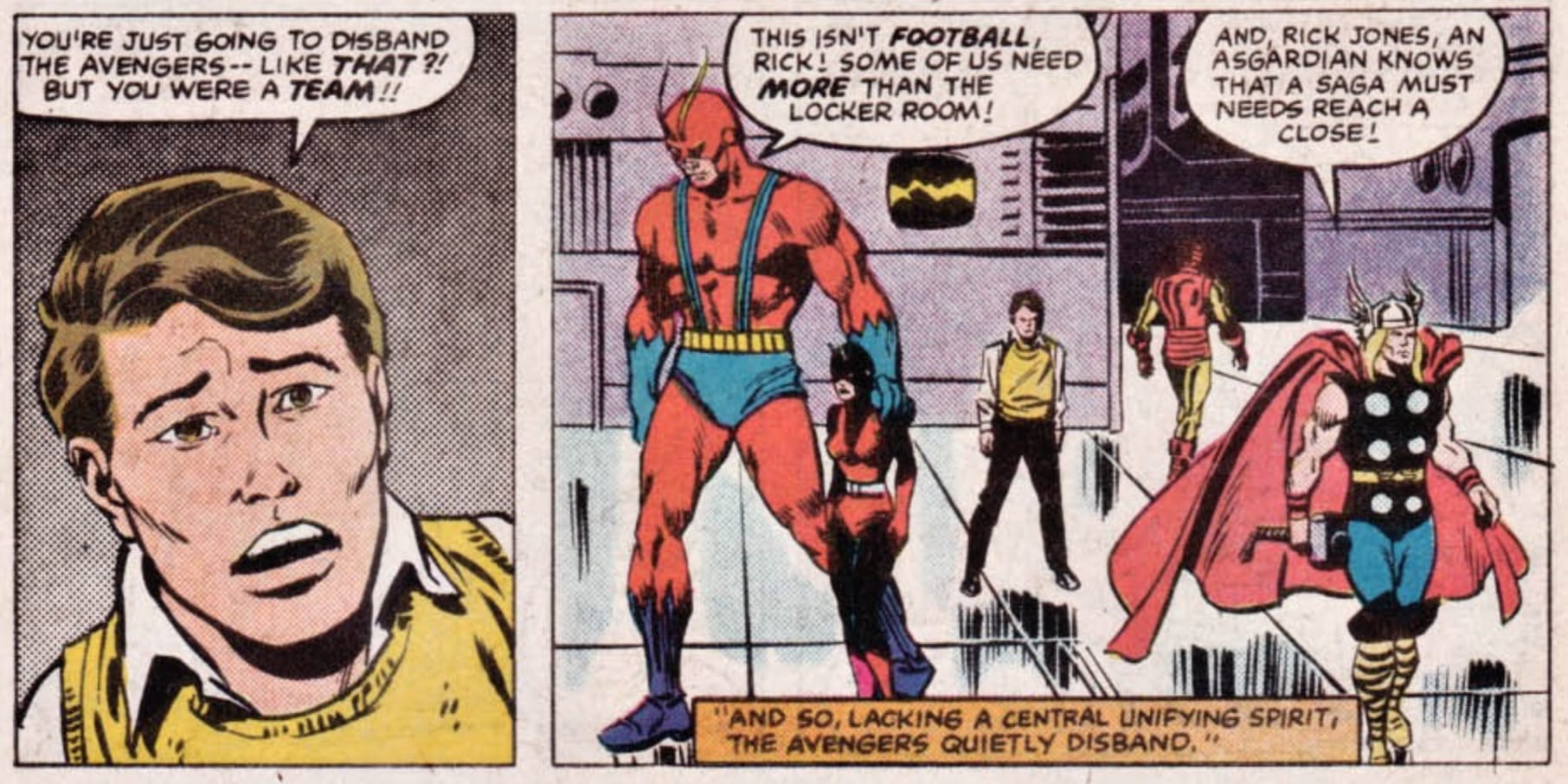
But the world still needs protecting.
So the film also asks: "Are the Thunderbolts up to the task?"
And The Thunderbolts asks this while using some big guns too. There's a lot of talent on display here, both in front of and behind the camera, as the fantastic "Absolute Cinema" trailer points out, that includes people who have worked on films like Midsommar, The Green Knight, A Different Man, Minari, Hereditary, and Everything Everywhere All At Once, amongst others. This isn't to say that the movie is reinventing any wheels here or anything, it's still a superhero film. But it is making some different and unexpected choices along the way, and having a good time while doing it. I loved it.
The film also asks: "Will the MCU be able to regain its status in the public eye by going back to basics with a group of squabbling outcasts who defy what it means to be a hero?" After all, the "disparate group of individuals who all rub each other the wrong way, and yet somehow must become a team" vibe was a hallmark of the first Avengers film. So will lightning strike twice and reignite that fire?
Probably not.
But not because a bunch of stupid nerds are mad that a specific genre of pop culture is popular with people who aren't stupid nerds for the exact same reasons that they are. More likely, it won't happen because superheroes are an inherently fascist concept. That's an unavoidable part of the deal, and you can't untangle that, and unfortunately, due to the unbridled hatred, a love of cruelty, and the insatible demand for entitlement that is just as unable to be untangled from white American culture as fascism is from superheroes, we now live in an openly fascist time, so... can superheroes stay friendly in this world? Will the studios, in a fit of capitulating self-preservation, fervid greed, and no small amount of eager complicity, somehow find a way to turn the superhero movie genre into a more obvious propaganda tool of militaristic right-wing authoritarianism? Or will it just seem this way, regardless of what actually happens? Has worldviews changes so much now that, for some of us, these characters, and their tireless pursuit of "truth, justice, and the American way" will inevitably begin to feel too much like the Nazis who are now building concentration camps on American soil and snatching people off the street?
I guess time will tell...

As far as this movie is concerned, I really enjoyed it. But that said, personally, I think it's a mistake to bring the Sentry into the MCU.
The Sentry was always a problem character in the comics, and he's going to be a problem character in the MCU for the same reasons. For one, Marvel doesn't need a Superman-type, and for two, that particular type of character is an awkward fit in the Marvel Universe. DC is all about the Gods and the Masks. Marvel is about the people behind the masks, people who have feet of clay. And while sure, The Sentry has his "feet of clay" like all the Marvel heroes do, in that should he use his powers, then he risks triggering the Void persona, what that means in a narrative sense is, if you want to use The Sentry, then you either have to ignore the whole issue with the Void, or you have to make room in your story for him to be the bad guy again, and that may not be what your story is about. So he's kind of forced to always be side-lined, except when you need a Deus ex machina, which is how I expect him to be used in the upcoming Avengers: Doomsday and Secret Wars films. And that is not very exciting. But even worse will be all the times when The Sentry isn't used, and we end up getting tons of terrible clickbait articles, all of which were probably written by shity GenAI, with a title like "The huge plothole in latest Marvel movie!" and if you click on it, you'll see it's just: "Why didn't they just call The Sentry?"
In a nutshell, Marvel has just gifted itself the MCU version of the Great Eagles in the Lord of the Rings, and the haters are going to hit this particular beat over and over and over again, and they're gonna be all smug and self-amused when they do it too, even though it's easy to explain away by a simply engaging with the text, but hey... if media literacy wasn't a crippling issue in America, we wouldn't be living in the dumbest and meanest times imaginable, under the thumb of the dumbest and meanest people who were ever born.
Also, personally, I think the fight with the chicken should’ve gone on much longer than it did. More like it does in Family Guy, in fact. It's not a dealbreaker for me or anything, I just enjoy watching a giant chicken get what's coming to him.
But those few complaints aside, while it's fair to say that the group hug at the end is as cheesey as the first Guardians of the Galaxy film ending in the Carebear Stare, I really did appreciate how the final act of the Thunderbolts attempted to be more emotionally grounded instead of just the usual slo-mo punch amid CGI-explosions. Your mileage might vary, of course, but I really liked how it was the message about the value of community and how we need to support each other.
As a result, while it's not a perfect film, due to its great action, its fun characters, and its well-drawn emotional stakes, the Thunderbolts ended up feeling more like a real movie than the last couple of films did, so I was also glad to see that.
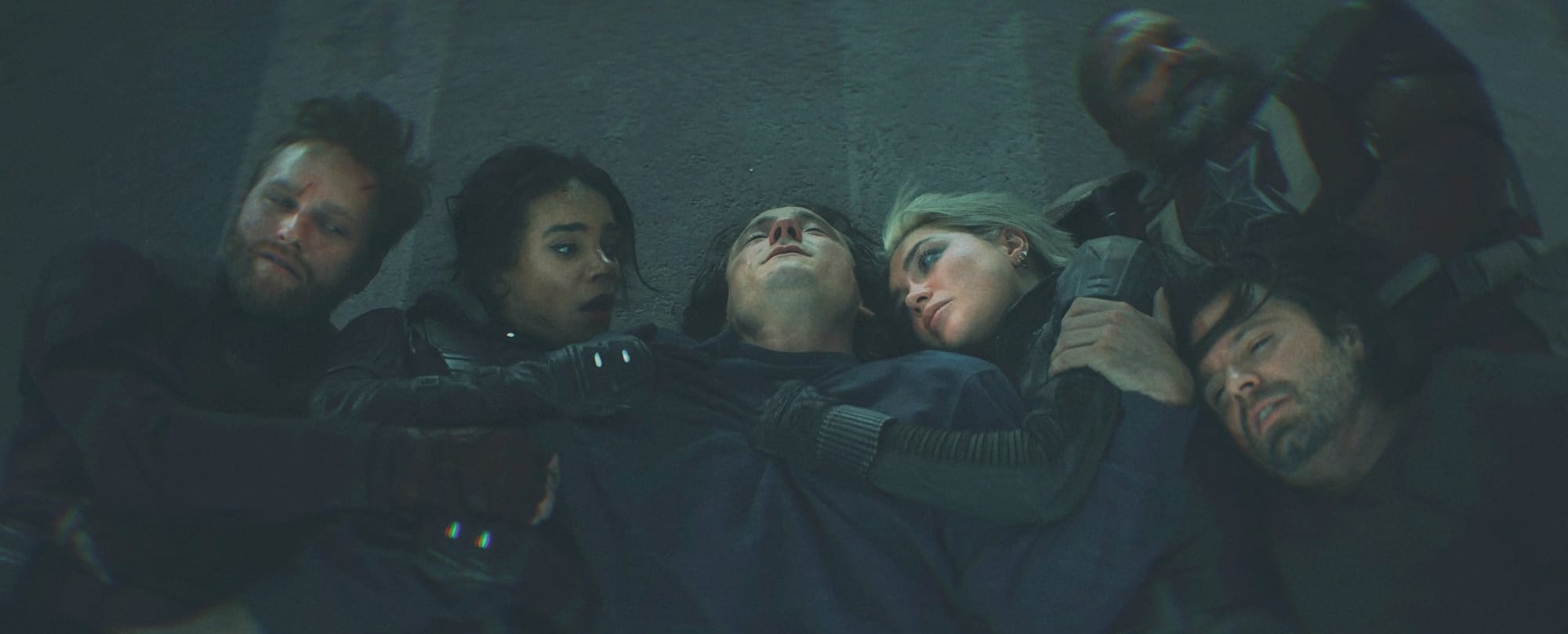
I also loved how the team name of The Thunderbolts was rationalized in the story. Very clever. Very funny. That was good stuff.
Anyway, I already watched this twice. Admittedly, this is not a particular sign of quality coming from me, as I watch all these movies twice eventually, but... my wife, who doesn't have near the tolerance for these films that I do, joined me for the second viewing of this film, so I'd call that a ringing endorsement.
Thumbs up.
